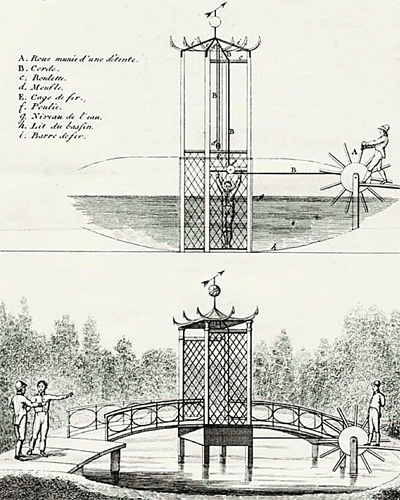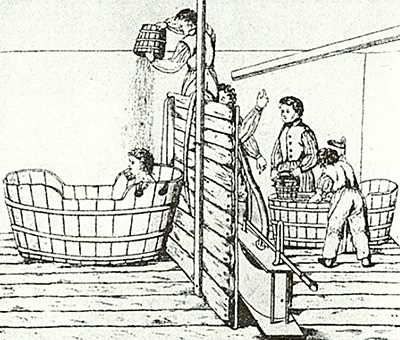BY LOUISA CORNELL
Taking the waters during the Georgian age was prescribed by physicians for everything from stomach troubles, to gout, to a nervous disposition. This cure usually involved a trip to one of England’s many spa towns, like Bath or Tonbridge Wells. It might entail a trip to the sea, to Brighton perhaps, to enjoy the efficacious benefits of the ocean breezes and the salt air. These treatments were basically harmless and, at times, quite helpful (so long as one did not mind the taste of the water at the Roman baths. Shudder!)
However, the last thing one wanted by way of medical treatment was hydrotherapy or water therapy as it was administered for cases of mental illness or madness, as it was more often called in the seventeenth through nineteenth centuries. The various forms this treatment took in this era ranged from mildly discomforting to death, not to put too fine a point on it.
The original proponent of water therapy for afflictions of the mind was Jean Baptiste Van Helmont. His method was first recorded in his magnum opus, Ortus Medicinae, which was translated into English in 1662. He believed in the full immersion of the patient in ice cold water to the point of unconsciousness. This near death experience would, he declared, result in the death of the mad idea which caused the derangement in the first place. Sometimes, in addition to the extermination of the mad idea, the treatment resulted in the extermination of… well, the patient. At least he was no longer mad. Dead relatives were far more acceptable during the Georgian age, especially the Regency era, than mad ones.

To be fair, this form of water therapy was not widely used after its side effects became apparent. Yes, even in the 17th century death was seen as a side effect.
Eventually methods of hydrotherapy that did not involve drowning the patient outright became popular among mad doctors, as they were called. For some practitioners it was a particularly appropriate title. By the late 18th and early 19th centuries, the two major forms of hydrotherapy were the douche or cold shower and the balneum or bath.
The bath was used more often for nervous disorders, to calm patients. The shower consisted of cold water poured over the patient’s head or sprayed directly into their face, and it was for the more violent forms of madness. Rather like turning a hose on dogs fighting. Even into the Regency era, the theory was madness was a spiritual rather than a physical or mental disorder. Therefore, a mad doctor had only to arrive upon the proper method to change the patient’s spiritual thinking to invoke a cure.
These doctors came up with a wide variety of methods by which to dispense this cure. Patients were wrapped tightly in sheets and placed in a cold bath, sometimes for hours on end. More inventive facilities had tubs with wooden doors over them with a hole for the patient’s head to stick out. Thus, the patient might be locked into the bath and left there until they saw the error of their ways.
The shower was the more violent form of hydrotherapy and was used for everything from murderous rages, to fits, to refusal to sleep with one’s husband (but we’ll get to that one in a moment.) There were cold shower rooms where the patient might be locked in and sprayed with water from all directions. The most common method was for the patient to sit in a tub or barrel of cold water whilst a number of attendants ran up and down a ladder on the other side of a screen and doused them with bucket after bucket of water. These sessions might go on for anywhere from twenty minutes to several hours, or at least until the attendants ran out of energy and/or water. All of this was done to force the patient to let go of his or her mad behavior and revert back to what was considered normal, upright, Christian behavior.

Enter the scene of mad doctoring in 1725, one Patrick Blair. He was firmly ensconced in the mental illness as spiritual failing camp of treating madness. Therefore, his use of water therapy was punitive to the point of torture. Eventually he created his own apparatus consisting of a pump capable of raising 18,000 gallons of water 35 feet and dropping it, in its entirety, onto a patient strapped into a chair. He even added water sprayed into the patient’s face at the same time as extra incentive.

Blair used this inventive piece of hardware most often to persuade women to return to their marital duties, aka go back to sleeping with their husbands. Yes, this was considered a form of madness no matter how nasty, abusive or sexually unimaginative the husband. His method consisted of stripping the patient naked, strapping her into the chair, blindfolding her, and subjecting her to the constant shower of cold water for thirty minutes to an hour at the time. This was done several times a day for as many days as it took for the woman to be cured of her dislike of her husband. Frankly, after this sort of treatment, most women would agree to go to bed with Jabba the Hut. One can only assume should the woman ever evince a further dislike of her husband, the threat of more of Dr. Blair’s cure would bring her back into line.
Modern psychiatrists, after reading Blair’s own account of this treatment on a number of women, have pronounced it nothing short of a kind of rape performed at the request of a husband to force the wife to take him to her bed. A fair assessment? I’d say so.
Whilst later practitioners in mad hospitals put aside water therapy in its most punitive forms in favor of good nutrition, pleasant environments, and what we call now, occupational therapy; water torture in the same form used by earlier mad doctors found its way into the prison systems. One of these techniques in particular is used today. It’s called waterboarding. Psychiatry has evolved. Mankind, a little less so.